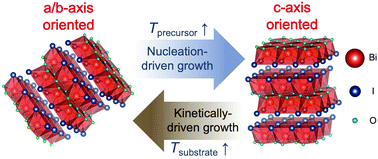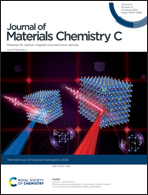Abstract
Bismuth oxyiodide (BiOI) has gained attention for photovoltaics, photocatalysis and photodetectors owing to its composition of non-toxic elements, tolerance to point defects, and highly-suitable optical properties. But like many other bismuth-based compounds, BiOI is a layered material with anisotropic transport properties, making control over the preferred orientation critical for achieving optimal device performance. In this work, we develop new insights into the growth mechanism of BiOI synthesized by chemical vapor deposition (CVD) and show how the preferred orientation can be controlled. By adjusting the precursor and substrate temperatures to tune whether or not we are in a nucleation- or growth-controlled regime, we reproducibly vary the ratio of the (001) and (110) orientations by over two orders of magnitude. As a result, we achieve highly c-axis oriented films, which leads to less shunting than a/b-axis oriented films, resulting in improved open-circuit voltages from a median value of 0.7 V (a/b-axis oriented) to 0.9 V (c-axis oriented) in BiOI solar cells. More broadly, the described mechanisms can be used to control the preferred orientation in other low-dimensional materials, which will be important for achieving improved performance across a wide variety of devices.

- This article is part of the themed collections: Journal of Materials Chemistry C Emerging Investigators and Journal of Materials Chemistry C HOT Papers


 Please wait while we load your content...
Please wait while we load your content...